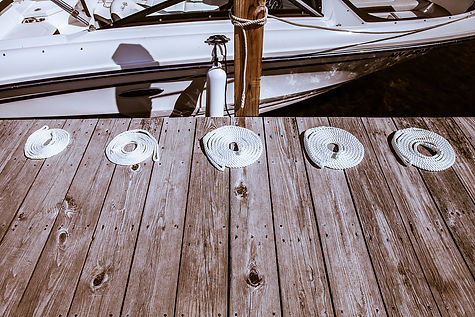DOCK LINES
Knotical Marine Lines dock lines are reliable to securely fasten your boat to a dock, or to another boat when rafting, either temporarily or semi-permanently. These applications demand different types of dock lines. Thanks to our American made nylon lines and Eye Splice technique, you can enjoy your time out on the water.
Dock Lines Materials and Application
The material is a synthetic fiber that is recognized for its outstanding strength, high stretch, and good abrasion resistance. It is ideal for applications where stretch and energy absorption are critical, such as in dock and anchor lines. Additionally, nylon suffers minimal strength loss when exposed to sunlight.
Premium grade, high-tenacity nylon fiber is treated with a proprietary Marine-Tech coating to improve fiber-to-fiber abrasion resistance. Construction is ideal for anchor, snubber dock lines, and mooring lines
How They Work
When your boat is away from its regular slip or mooring, you need to have some designated nylon lines aboard, preferably with spliced eyes, ready for use when you tie up somewhere. They call these transient dock lines. The eye, in the end, is easily passed around a cleat or piling by someone on the dock and the bitter end is adjusted on board. There are dozens of combinations of diameters and lengths.
Permanent dock lines are also made of nylon but differ from transient dock lines in several ways. First, they must be protected from chafe, the enemy of all lines in constant use. This calls for leather, rubber or fabric chafe gear where the line passes through the chocks, and possibly a chafe sleeve on the eye where it goes around the cleat on deck. At the dock, lines should be protected from chafe using eye splices and shackles if the dock has rings, or eye splices and short lengths of chain if the dock has cleats. Permanent dock lines should be cut to fit the boat in the slip.

The diagram below shows four lines in use. Although the stern line will keep the boat from moving forward too much, to be safe a fourth spring line running from the dock cleat forward could be used.
Diameter: Recommended line diameter for boat length.
Double Braid or 3-Strand?

3-Strand Dock Lines
-
Do not snag
-
Less costly than braided rope
-
Durable enough to use as transient dock lines
-
Easier to splice
-
More stretchy
-
Absorbs shocks
Knotical Marine Lines 3-Strand Lines are ideal for applications where grip, abrasion resistance, and stretch are critical factors. The construction of our 3-strand lines is perfect for anchor, dock, mooring, and tow lines up to 1-1/8”. They’re even great for rigging on traditional cruising boats, tailored boats, and for other applications that don’t require maximum strength or heavy-duty abrasion resistance. The four-stage, balanced construction leveraged with an advanced stabilization process produces a durable, long-lasting and flexible rope that won’t harden with age.

Double Braid Dock Lines
-
Manufactured from UV resistant nylon
-
Flexible and easy to handle
-
Available in a host of colors
-
Tend not to tangle and stows with less capacity
-
Controlled stretch and elongation
-
Does not hockle under load
-
A rope within a rope
-
Inherently "size for size" 15% stronger than 3-strand nylon
Knotical Marine Lines Double Braid Dock Lines are proudly manufactured from 100% North American, Firestone "NYBRITE 6000" Virgin Nylon fibers, offering competitive pricing with other high-quality Double Braid Dock Lines companies. With their solution dyed colors, our lines have brighter and longer lasting results. The Braid and Jacket Pick construction of our lines produces a softer material that helps with them being more resistant to chafe. By the eye-splice technique, our lines utilize a 25% longer insertion to the core to result in a stronger, more reliable splice that does not require whipping. Each Bitter End is fully heat sealed on the end and circumference to allow for easy and unobstructed rigging with Snubbers—no whipping necessary!
ADDITIONAL INFORMATION ON DOCK LINES
Tying Off Boat Lengths
Transient dock lines should be about 2/3 of the boat’s length when used on the bow and stern. Spring lines should be equal to your boat’s length.
Spring lines are dock lines that run forward from the stern, or aft from the bow of the boat to the dock. They oppose the tension on the bow and stern lines and keep the boat from surging fore and aft.
Mooring Snubbers absorb shock loads and reduce stress to protect boats, cleats, and lines from the strain of windy conditions, waves or high traffic areas. They also create a cushion for your lines when docking. This helps keep your boat stable in less than ideal docking conditions.

Line Handling When aboard a boat, ropes are no longer called ropes, they are called lines. At least three and preferably four lines should be carried aboard for docking:
-
A bow line with a snubber to secure the bow;
-
A stern line with a snubber to secure the stern, and;
-
At least one spring line to reduce fore-and-aft movement.
The diagram below shows four lines in use. Although the stern line will keep the boat from moving forward too much, to be safe a fourth spring line running from the dock cleat forward could be used.
WARNING: Any well-designed and well-built product will fail if abused, misused or overused. It is of the utmost importance that anyone purchasing these products is sold with the express understanding that the purchaser is thoroughly familiar with the correct application of the products design and construction along with its safe use thereof. Failure to use all products properly, in a safe manner and for the application for which they were intended could result in property damage, bodily injury or both.

